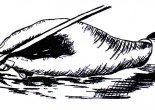Game On!
Since Sportsnet won the bid for national hockey rights, can TSN’s reporters keep their broadcasting lead?

Rick Westhead stands half-dressed in the empty parking lot of BMO Field, Toronto’s soccer stadium. After hurriedly buttoning up his white shirt, he grabs a tie and blue suit jacket out of the back seat of his Jeep, using the window as his mirror. He just came from playing shinny and could have easily put the suit on at the rink, but he would rather stay comfortable as long as possible. As Westhead finishes dressing, TSN cameraman Marc Malette pulls up beside him and exclaims, “That’s not your look!”
Westhead chuckles. He can only recall a couple of times when he had to wear a suit during his 12 years at the Toronto Star. Now that he’s a senior correspondent for TSN, things are a little different. The suit is just one part; wearing a cage on his hockey helmet to avoid a puck in the face is another.
He’s here to interview Earl Cochrane, the Canadian Soccer Association’s deputy general secretary, about the organization’s support of Bill C-290, a private members bill that would permit single-event sports gambling in Canada. Westhead sets up with Cochrane on the sideline of the field, not quite sure how close to stand or where to hold the microphone. Malette helps him out with each shot.
Westhead may be a rookie when it comes to television, but he’s a veteran reporter, having worked for several publications including the Star, Bloomberg News and The New York Times. Since joining TSN in August 2014, he’s been chasing sports stories as far away from press conferences as possible, whether it’s outlining a hostage drill practiced by the federal government before the Sochi Olympics or exposing rampant steroid use in Canadian collegiate sports. He’s an integral part of TSN’s growing commitment to business, investigative and human-interest sports journalism—an investment that could be essential after the network’s recent loss in the battle for national NHL hockey rights.
In November 2013, Rogers Communications Inc. (the parent company of TSN’s main rival Sportsnet) paid $5.2 billion to become the NHL’s exclusive broadcaster and multimedia partner in Canada through the 2025-2026 season. It’s now airing several games every week across nine channels including CBC, City, FX Canada and the array of Sportsnet stations. It’s also bolstered its broadcast teams, expanding to 30 analysts and reporters focused on hockey throughout the country. George Stroumboulopoulos is now the face of Hockey Night in Canada, while long-time HNIC host Ron MacLean leads Sunday night’s Rogers Hometown Hockey. TSN retained some regional games for the Toronto Maple Leafs and Winnipeg Jets, as well as the Montreal Canadiens on its French sister station RDS. Both stations now also air Ottawa Senators games. But after losing the bid for national rights, TSN is in the unexpected position of having to re-evaluate exactly what it means to be “Canada’s Sports Leader.”
For years, TSN held the widely accepted journalistic edge in sports broadcasting. In Canada, hockey reigns, and TSN has insiders such as Bob McKenzie and Darren Dreger—respected reporters who have made careers out of breaking hockey news. Like ESPN in the United States, which has in recent years released improved video features and documentaries such as its 30 for 30 series, TSN has seen the value in covering sports in the context of the greater culture, outside the vacuum of the arena.
ReOrientation, the three-part series exploring homophobia in pro sports hosted by former NHL player-turned-analyst Aaron Ward, aired in January 2014. In June 2013, the network produced Neutral Zone, a documentary set in a hockey school in northern Israel that examined whether having Jewish and Arab children play hockey together could promote tolerance. Such engaging storytelling and in-depth reporting is increasingly important in sports journalism. Brian Cooper, a former vice-president of business development and operations at Maple Leaf Sports and Entertainment, sees everyone looking for the “extra edge” to draw in viewers; now that edge means having more to say than who played well in a game. “It’s everything about the league and the personalities that make it up,” Cooper says. “You have to go much deeper than ever before.”
Not just that, says Ken Volden, TSN’s vice president and executive producer of studio production and news information: “You have to give context; you have to be trusted.” His network’s brand, he says, is “Sports. Information. Entertainment,” and his goal is to make viewers feel something when watching TSN. To do that, he needs to hire strong reporters. “Substance, more than ever, matters.” But Sportsnet’s shadow looms ever-larger thanks to its expensive broadcast rights, improved production values and expanded roster of expert analysts and seasoned journalists. TSN can no longer simply coast on its reputation: “Canada’s Sports Leader” now has to prove itself.
***
Westhead fits neatly into TSN’s effort to emphasize emotionally stirring yet journalistically sound
storytelling. During his time at the Star, he served as the paper’s South Asia bureau chief based in India. When he returned to Toronto in late 2011, his reporting focused on foreign affairs and international development, while also dipping into some sports business. He chased stories that looked at the inner workings of Russia’s national hockey league expansion and the profitability of the Canadian NHL market as the game floundered in the United States after the 2005 lockout. “I think he views the world differently than someone who’s covered a team for 20 years,” says Volden, adding the network will continue to target reporters like Westhead: storytellers.
In the 1990s and even early 2000s, sports broadcasters trailed far behind newspapers when it came to breaking news. The networks would read the papers, then get the writers on air the next day to talk about their stories. They showed games, but did little original reporting outside of them. Over the past few years that mindset has shifted; networks now want to lead. Instead of piggybacking on print, they’re hiring the journalists who were writing those stories and turning them into on-air talent, bloggers and columnists for their websites.
Westhead joins the growing list of writers that sports networks have wooed away from print. In the past four years, TSN poached Mark Masters and Matthew Scianitti from the National Post. In 2011, Sportsnet lured Michael Grange from The Globe and Mail and, more recently, brought on Damien Cox, who’s now full-time at Sportsnet, though he still writes a column for the Star once a week. This is due, in part, to the shrinking pool of up-and-coming sports broadcasters: smaller shows such as Sportsline (later known as Global Sports) no longer exist. Only Sportsnet and TSN are left standing, both major networks owned by telecommunications giants. “Where do you hire your next wave of people,” Volden asks, “when there are so few television shows other than at our level?”
Westhead didn’t want to be a talking head, so it took several months of negotiations to convince him to join TSN. The network has given him plenty of journalistic freedom. In November 2014, he travelled to China to explore the world of counterfeit jerseys, tickets and memorabilia. He’s also reported on former CFL all-star Arland Bruce’s lawsuit against the league—one of TSN’s major broadcast partners. In the lawsuit, Bruce alleges the CFL doesn’t do enough to protect its players or educate them about the long-term effects of concussions. The suit also alleges the league is misleading the public about the dangers of playing football after such injuries. The allegations have not yet been proven and the CFL has asked for the case to be dismissed.
Chris Zelkovich, a sports media blogger for Yahoo! Canada who has been covering the sports industry for 17 years, says he’s never come across a sports reporter with Westhead’s responsibilities—to work in courts, gain access to executive boardrooms and file freedom of information requests, rather than break trade deals or file game recaps. This, Zelkovich says, is part of a greater trend in Canadian sports broadcasting: hosts and analysts becoming more professional. He’s noticed that the Rogers-run HNIC has a tougher journalistic approach than before. As a CBC production, analysts referred to NHL executives by their nicknames, calling former Leafs general manager Brian Burke “Burkie” and then-chief disciplinarian for the NHL Colin Campbell “Collie.” “These were their friends,” says Zelkovich. “But you’re not going to hear that now. There’s less of a feeling that, ‘We’re all in this together.’”
Sportsnet began stepping up its storytelling game in 2011 with the launch of its own biweekly magazine, which immediately became the only magazine dedicated to longform sports writing in Canada—a venue where 2,500-word stories are “lighter” pieces and major features run more than double that length. Dan Robson was one of the first employees hired to work as a senior writer at Sportsnet Magazine, leaving his job at the Star. “There’s no real outlet like this in Canada,” he says. “Sport lends itself to narrative, and this gives us a place to explore it.”
The writers measure their work against all other longform sports journalism written in North America, Robson says, whether it’s in Sports Illustrated or The Walrus. But there are only two major players in English-speaking Canada for cross-platform sports journalism, and he writes for the magazine arm of one of them. He can’t ignore TSN, even if it doesn’t have its own comparable publication. But with Westhead on board, Robson says, the network is making a statement that the days of running a website that relies largely on Canadian Press copy are over. “When I see Westhead go to TSN, I think we need to be reminded that this is a very competitive market.”
And compete Sportsnet has. Over the past few years, it has earned viewers’ attention with a solid team of reporters adding colourful insight, smart analysis and context to stories around the games that easily rivals TSN’s efforts. Where TSN is staking a unique position, though, is in its longform video features. To commemorate the 25th anniversary of the fall of the Berlin Wall in November 2014, the network aired a documentary about former NHL players Peter and Anton Šťastný, who escaped from Czechoslovakia in 1980, and their older brother Marián who joined them in Canada one year later. Viewers praised the feature, with commenters on social media calling it a great piece of journalism. In October, three months after joining the network, Westhead got his first shot at a video feature of his own.
***
Sitting in a dimly lit school gymnasium, Westhead studies his typed notes, furiously scribbling out interview questions he doesn’t like and writing in late additions by hand. Seventeen-year-old Sameer Fathazada sits across from him, staring into space, not quite sure what to do with himself while he waits for a question. The production lights flick on and it’s time to begin. Westhead gently guides Fathazada through the telling of his life story for the camera. He arrived as a refugee from Afghanistan in 2007, and is now being touted as the next Canadian soccer superstar. He’s been on two training stints with different German clubs, and if he went to play there, he could become a German citizen and qualify for their national team. This might be a goal for some players, Fathazada explains, but it’s not his. “It’s important for me to represent Canada because of the things they’ve done for my family,” he tells the camera. “There’s no other way to repay them than do something good for the country like play for the national team.” It’s a made-for-television moment.
“These are the stories that get me excited,” says Westhead. Normally, you might expect a feature on Fathazada after his first appearance for Canada, or if he signed a professional contract (and there’s no certainty he ever will). But it’s his story off the field that Westhead finds special: “It shows that there are good news stories to tell from us being in Afghanistan,” he says. It connects us as Canadians, whether or not you care about soccer. But this is still television. After the interview, the TSN crew stays to watch Fathazada’s game. During the second half, they shoot some footage of him as he rests on the bench—at one point even dressing the teen in a Team Canada jersey and having him pose with the Canadian flag draped around him.
Last year, Westhead might have turned Fathazada’s story into a Star feature, finding the power in the player’s words and history.But television adores these sorts of images—a talented young refugee, literally wrapped in his adopted country’s flag. Such stories hit Volden’s target dead centre: they make people feel something. Westhead’s job, then, is to elicit that emotional response without sacrificing journalistic integrity. That’s a challenging task when images are as important as words in a story.
As he drives home from the match, his car smelling of the Afghani food Fathazada’s mother gave him, he recounts his time in Japan right after the 2011 tsunami. “I was stuck in Sendai, relatively close to the Fukushima reactor that everybody was worried about. I didn’t know if I could get out,” Westhead says. “It’s thrilling when you feel like you’re in the centre of these stories. It’s what so many journalists want—to be there, to witness and document it.”
As he drives, he talks about the people he met there. One man got separated from his wife and went scuba diving through their town looking for her. He found her, alive, after three days. Another family wasn’t so lucky. As the warning sirens blared, a daughter helped her mother up the stairs to a safer floor of their house, then went back to get her own child. The daughter came back and handed over her child, just as a wave came crashing in and swept her away, leaving grandmother and grandchild clutching each other.
He pauses. “It’s tough after doing that kind of journalism to find anything that’s going to be like it.” Stories like Fathazada’s may be as close as he gets. The war in Afghanistan was long, the costs to both that country and Canada high, but here was a positive story to dig out of the aftermath. As the crew shot footage of her son, a giant smile stretched across the face of Fathazada’s mother. Westhead was smiling too: here’s a kid who survived, came to Canada and now has a chance to become a professional soccer player. You see Fathazada smothered in the country’s colours, but you hear his words, and the thought that creeps in—that this is shameless jingoism—is drowned out, even if only for a moment. There’s joy and hope here. In Westhead’s care, it’s more nuanced than most sports stories. In his telling, it’s tough to say this is just about a game.
***
At Toronto’s Air Canada Centre, TSN reporter Mark Masters gets set to watch the Leafs play the Tampa Bay Lightning. Two nights earlier, the Leafs suffered an embarrassing 9-2 loss to the Nashville Predators, so when the time comes for his pre-game over-the-boards interview, Masters goes after captain Dion Phaneuf, asking him about the team’s mood and what they need to do to improve. After the second period, Masters catches up with Leafs forward James van Riemsdyk—whose two-goal night would help lift Toronto over Tampa Bay—before he can enter the dressing room. “We want to be first to get player reactions,” says Masters. “They still have energy, they haven’t gone into the dressing room yet—it’s unfiltered.” But many athletes are now experts when talking to journalists, and those about to play a game will rarely give an answer worthy of a nightly recap show. “I’m not going to lie and say there’s always insight,” says Masters. “But there’s a chance, and why wouldn’t you do it if there’s a chance?” This access to players is a large part of what companies pay for with broadcast rights. Masters is down at ice level tonight because TSN is showing the game, but on Saturday he’ll be back up in the press box.
For hockey analysis, says Zelkovich, TSN has always been the leader, but “the problem for them is people will already be watching the game on another channel and won’t flip back to see what TSN is saying.” Cooper agrees that while TSN has the edge for now, Sportsnet is quickly catching up in terms of numbers of viewers. Cross-promotion means strong journalists, such as Cox and Elliotte Friedman, are showing up everywhere from news shows on Sportsnet to HNIC on CBC, as well as the website and radio stations. Stroumboulopoulos, too, is a dynamic interviewer who’s already managed to make interesting television with Sidney Crosby and Wayne Gretzky—not exactly the most controversial speakers. He also takes some weight off analysts such as Nick Kypreos, who’s far more natural having fun on the fake ice rink in the studio, acting out plays as former player and current analyst Kelly Hrudey chirps him from the net.
With a program that seems, for once, carefully crafted and suited to the skills and strengths of its contributors, it could be only a matter of time before Sportsnet overtakes TSN as the place to be for analysis too. “The public is getting used to them,” says Cooper. “Sportsnet seems irreverent and younger, while TSN is more serious and older.”
Irreverent or not, Sportsnet is making a serious bet with the NHL; the 12-year partnership has the network airing 350 national regular season games over nine channels. That’s a lot of hockey, and this season’s first Saturday night did earn HNIC a record 9.8 million viewers. But Zelkovich says the television business doesn’t run on audience reach—it’s more concerned with the average viewers per minute, and by that measurement, the inaugural HNIC broadcast was actually down from last year. According to Numeris broadcast ratings, Rogers’ average for Eastern games on opening weekend fell 40 percent from 2013.
The problem may be that Rogers, despite its enviable rights, is spreading the games across too many channels. But this partnership is still young, and its legacy will ultimately be much more than just a few early weeks of subpar performances. The network, Cooper points out, is creating new viewing days, and in a few years, Sunday night hockey could be a tradition of its own. Whatever learning curve Sportsnet experiences adapting to broadcasting all this hockey, it’s a better problem to have than the alternative.
***
On a September afternoon, Westhead sits at TSN headquarters in suburban Toronto as he and senior producer Paul Harrington discuss an upcoming video piece on the amount of income tax paid by NHL players. Westhead suggests focusing on three players: Phil Kessel of the Leafs; Dave Bolland, a former Leafs player who is now with the Florida Panthers; and Steven Stamkos, the Tampa Bay Lightning star from Markham, Ontario, who’s rumoured to be thinking about a move to Toronto in 2016 when he becomes a free agent. The premise is that Canadian taxes eat a lot of players’ salaries: Kessel is suffering, while Bolland pays no state income tax in Florida—will this affect Stamkos’s decision? Westhead leans back in his chair, legs stretched out, hands on his head, visualizing the piece. He wants to lead with Stamkos, the biggest star, but Harrington, the veteran producer, disagrees. “I’d put Stamkos last. He’s the meatier story, but he’s also theoretical, which works better with an actual example.”
Westhead mulls it over: “So, don’t take our word, ask Dave Bolland.” He laughs, sitting up and clapping his hands together, agreeing with Harrington. “This is completely different than newspapers,” he says. The rookie is learning how to mix good journalism with entertaining television. “It’s not for everybody—a piece on income tax in the NHL,” says Westhead. “Some people won’t want to see that every day on TSN, but it’s an important part of the business of hockey. If it’s helping drive decisions by free agents, then it’s worth people having a better understanding of how it works.” He returns to his desk, pounding out emails quickly on his laptop, coordinating a phone interview for a sports gambling story in a few minutes.
Westhead is slowly settling into his suit. “Television is really not easy,” he admits, but TSN is counting on him to master the technical aspect of it. He’s an essential piece in the effort to compete with Sportsnet.
Both networks are chasing many of the same stories, interviews and footage around the rink—and Sportsnet is just going to keep getting better at it. TSN needs Westhead to be out in the field, not just breaking stories, but setting a standard.
by Cormac McGee
Cormac was the blog editor for the 2014-15 issue of the Review. As a fourth year undergraduate at the School of Journalism, he had a keen interest in sports and business writing. He also hosted the Krates Collective hip hop podcast.
















































Pingback: Seen & Heard – Weekend Edition Toronto Sports Media Blog